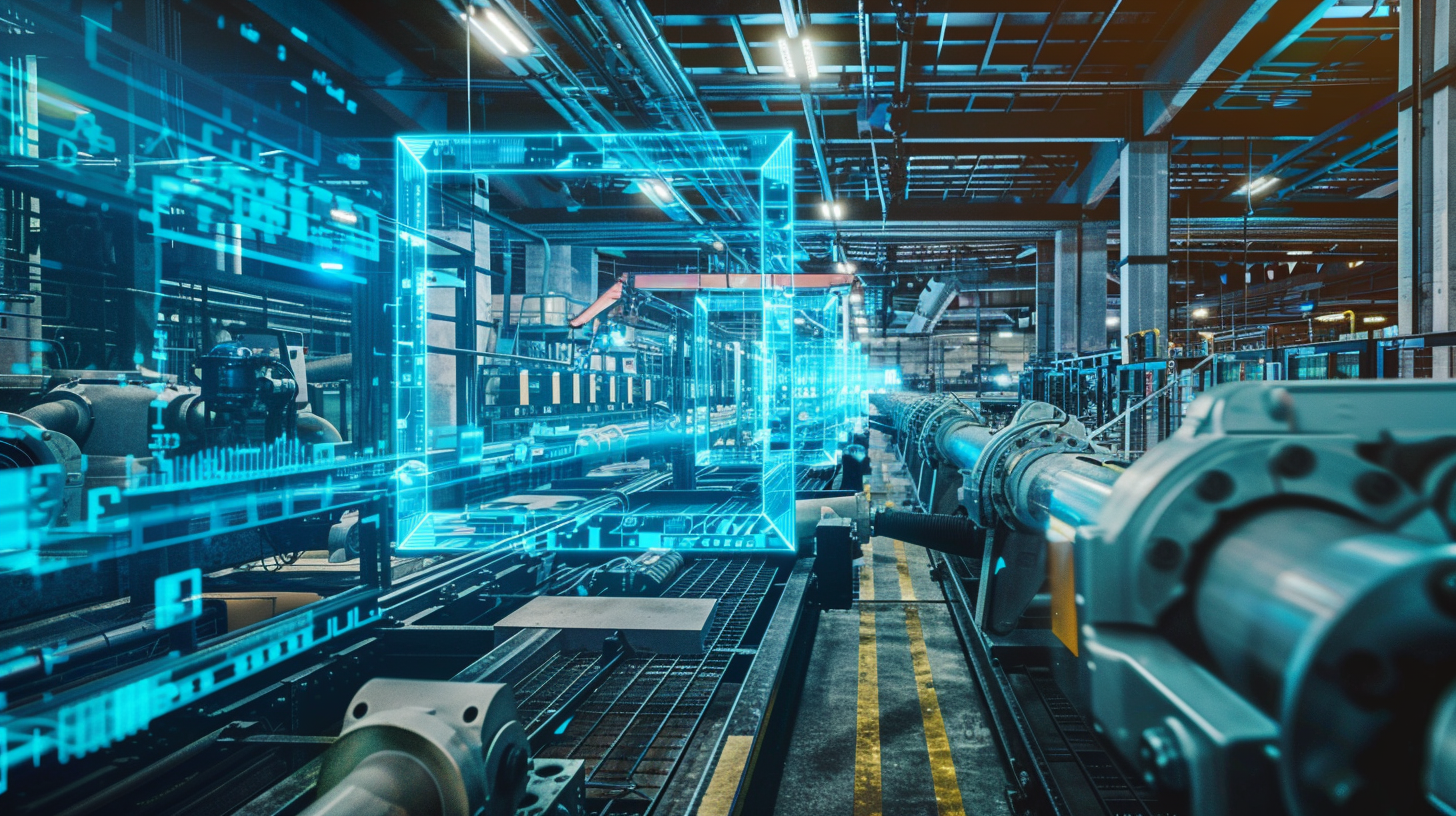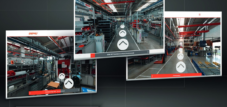Virtual twins, real advantages: The next step in production into the digital future and Industry 4.0
Language selection 📢
Published on: December 8th, 2024 / Update from: December 8th, 2024 - Author: Konrad Wolfenstein
🌐💡 The virtual twin: key technology of the future
🔍✨ Virtual twins: New dimensions for the industry
Virtual twins have long been considered a crucial key to making production processes more efficient, cost-effective and sustainable. While the progressive digitalization and networking of machines, systems and entire production lines as part of Industry 4.0 becomes increasingly important, digital images of physical products, systems and processes open up completely new possibilities. These virtual representations enable companies to carry out extensive simulations, tests and optimization long before the physical production of a product. In this way, development costs can be reduced and quality can be increased, ultimately leading to a more sustainable, flexible and competitive manufacturing landscape. But what exactly is behind the term “virtual twin”, how can its potential be fully exploited, and what influence does this technology have on our industrial future?
🖥️🤖 Virtual Twins: Digital reflections of reality
The virtual twin, often referred to as a digital twin, is at its core an accurate, digital replica of a physical object, process, or even an entire system. It doesn't matter whether it's a single machine, a complex production line, a complete factory or an end product. The digital image reflects all properties, functions and states of its real counterpart and is continuously updated with real-time data from sensors, machine controls or other digital sources. This creates a dynamic, digital model that provides a complete and up-to-date overview of the condition of the real object at any time. You can imagine this model like a constantly updated mirror that allows you to transfer the real world into a virtual environment and examine it there as you wish.
A key advantage of this concept is the ability to play through different scenarios without using up real resources or even causing damage. In this way, companies can test new materials in a digital development room, optimize production processes, better plan maintenance intervals or identify possible weak points at an early stage. A virtual twin does not just represent static properties, but is a living, constantly changing system that operates on the basis of data, algorithms and models. Production managers, engineers and maintenance personnel can understand complex processes in detail in real time and at the push of a button, initiate possible improvements and make precisely coordinated decisions.
🌍🔗 Industry 4.0 and the virtual twin: The digital ecosystem
In the context of Industry 4.0, networking plays a crucial role. The integration of the virtual twin into a comprehensive digital ecosystem enables different business areas and systems to communicate with each other. Sensors in production plants continuously provide data such as temperature, pressure, vibrations or utilization. An enterprise resource planning (ERP) system can provide information about material availability or supply chain status. Simulation and analysis tools prepare this data and provide recommendations for action. All this information flows into the virtual twin. The connection to other future technologies such as artificial intelligence, machine learning or the Internet of Things (IoT) makes it possible to gain valuable insights from data, create forecasts for future developments and optimize processes autonomously.
⚙️🔧 Application: Predictive maintenance and increased efficiency
A specific application example can be found in predictive maintenance. Instead of adhering to strictly defined intervals for replacing components, the actual stress on the machine components can be evaluated in real time via the digital twin. Intelligent algorithms can be used to determine when a part is likely to reach its maximum permissible service life and whether a failure is imminent. In this way, downtimes can be minimized, maintenance operations can be planned efficiently and failures can be avoided from the outset. The virtual twin provides precise information about when and how maintenance measures should be implemented in the most sensible way. The result is increased asset availability, extended equipment life, reduced downtime and ultimately higher overall productivity.
🚀🛠️ Product development: Design flexibly and quickly
But the benefits are not only enormous in the maintenance environment. Another central area of application is product development. Companies have long been relying on holistic digital concepts in which new products are first designed, simulated and tested completely virtually before the first prototype is created in reality. The development phases can be shortened drastically and the use of materials and costs can be reduced. If requirements or standards change in a late phase of development, the digital twin can be flexibly adapted to the new circumstances. The result is a smoother, faster and more resource-efficient innovation process that gives companies a significant competitive advantage.
📈🎯 Customer orientation: Develop tailor-made products
The digital twin is also extremely important when it comes to adapting to customer requirements. Individual customer requests that once required a complex special design can now be implemented much more quickly. The production process can be flexibly adjusted because changes are first tested virtually. Customers are integrated into the development process earlier, receive comprehensive insights into the designs and can incorporate their suggestions directly into the virtual model. This close connection between manufacturers and customers leads to products that precisely meet the needs of the market, without the need for extensive physical testing.
♻️🌱 Sustainability thanks to digital twins
In addition to increasing efficiency, the virtual twin also offers significant advantages in terms of sustainability. Precise simulations and analyzes can be used to clarify in advance how material use and energy consumption can be minimized. This applies to both individual components and entire production systems. Maintenance work is carried out in a targeted manner, less waste is generated and energy consumption can be continuously optimized. Overall, this contributes to an economically and ecologically sensible design of industrial processes. In this way, the virtual twin fits seamlessly into the concept of the circular economy, in which products and materials are kept in the value chain for as long as possible.
🏭👷♂️ The impact on the world of work
The impact on the world of work should not be underestimated either. Skilled workers in industry can benefit significantly from the new opportunities. The digital twin provides engineers, developers, production managers and maintenance specialists with a reliable tool that makes data-based decisions easier. Instead of making vague assumptions, you can rely on solid, fact-based and constantly updated information. This not only makes work more efficient, but also safer. Complex processes become transparent, sources of errors are identified early on, and work processes can be coordinated better. Last but not least, this also increases the quality and value of the goods produced, because possible quality defects can be identified and eliminated in the planning phase.
💰💻 The necessary investments and challenges
However, the virtual twin is not a solution that can be introduced without effort. Companies must be prepared to invest in digital infrastructure, sensors, data processing and the necessary software. Specialized expertise and training are also required to exploit the full potential of virtual images. But anyone who takes this step will be rewarded in the long term. The introduction of digital twins is more than just another technical gimmick - it marks a real milestone on the way to the factory of the future. This factory is highly flexible, highly automated, sustainable and closely linked to other levels of the value chain. It reacts dynamically to changes in the market, fluctuations in the supply chains or unforeseen events.
🔍🕹️ Scenario planning with digital twins
With the help of digital twins, production planners can already run through various future scenarios today. What happens if demand for a particular product suddenly increases sharply? How can production capacity be expanded quickly and without sacrificing quality? Which bottlenecks in the material flow would occur and how can they be avoided in good time? All of these questions can be answered in the digital space before they manifest themselves in the real world. The virtual twin also offers valuable assistance with regard to global crises, volatile markets or new legal requirements.
📈🌎 The scalability of digital twins
Scalability is another key aspect. A virtual twin does not have to be limited to a single product or machine. Entire production sites can be transferred to a digital world. For the first time, this offers the opportunity to map complex supply chains, production in different countries or even the interaction between different plants in a uniform and transparent manner. This means that global processes can be coordinated better, resources can be distributed more efficiently and strategic decisions can be made more soundly.
🔐🛡️ Handling sensitive data
At the same time, as digitalization progresses, the responsibility for dealing with data increases. The virtual twin is based on a constant flow of data: it accesses design data, production parameters, sensor measurements and much other information. It is essential that companies establish robust security concepts to protect their sensitive data from unauthorized access. Protecting the privacy of employees and business partners is equally important. Data must be carefully managed, access rights clearly defined and security measures regularly reviewed. This is the only way to ensure that the virtual twin does not become a weak point, but rather a strong pillar of the company's strategy.
🌍🔗 From Industry 4.0 to digital integration
Overall, the virtual twin is more than a technological trend. It is the next logical step in a development that leads from pure automation, through networking, to the complete digital integration of all company areas. Industry 4.0 describes exactly this path in which the digital and the physical are merging ever more closely. Real production is expanded to include a virtual level in which errors can be detected cost-effectively, innovations can be accelerated and resources can be used more efficiently.
🏗️🩺 Beyond the manufacturing industry
Looking to the future, it is becoming apparent that virtual twins will not only play a role in the traditional manufacturing industry, but will also find their way into other industries. Applications in logistics, construction, medical technology or even agriculture are conceivable. Wherever processes are complex, cost-intensive and closely interwoven, a digital counterpart can help to better understand, control and adapt them to future challenges. Virtual twins are already creating real advantages today by helping companies remain competitive, act in an economically sensible manner and always keep an eye on the increasing requirements for environmental and climate protection.
🛠️🌟 The virtual twin as a milestone
Ultimately, the virtual twin symbolizes a new era of industrial value creation in which the interaction between people, machines and digital tools becomes a matter of course. Its ability to make complexity manageable, reduce costs, minimize risks and promote innovation makes it an indispensable companion for everyone setting out on the path to the digital future. It is less a question of whether to deal with virtual twins, but rather when and how intensively. Those who make the right decisions early on will benefit from the real benefits that this technology brings. It can already be said today: Virtual twins mark the next step in production into the digital future and form a central foundation for successful Industry 4.0.
📣 Similar topics
- 📢 Virtual twins: key to the factory of the future
- 🌍 Promote sustainability through digital images
- 💡 Accelerate innovation with digital twins
- 🛠️ Optimize production: Virtual twins in everyday industrial life
- 📊 Data-driven: What the digital twin enables
- 🔒 Security and privacy in the world of virtual twins
- 🤖 Industry 4.0 and the next step towards digitalization
- 🌱 Circular economy rethought through simulations
- 🧩 Networking and interaction: Digital twins in practice
- 🔜 Visions of the future: How virtual twins are transforming the industry
#️⃣ Hashtags: #VirtualTwins #Industry4Zero #Digitalization #Sustainability #Futuretechnologies
Our recommendation: 🌍 Limitless reach 🔗 Networked 🌐 Multilingual 💪 Strong sales: 💡 Authentic with strategy 🚀 Innovation meets 🧠 Intuition
At a time when a company's digital presence determines its success, the challenge is how to make this presence authentic, individual and far-reaching. Xpert.Digital offers an innovative solution that positions itself as an intersection between an industry hub, a blog and a brand ambassador. It combines the advantages of communication and sales channels in a single platform and enables publication in 18 different languages. The cooperation with partner portals and the possibility of publishing articles on Google News and a press distribution list with around 8,000 journalists and readers maximize the reach and visibility of the content. This represents an essential factor in external sales & marketing (SMarketing).
More about it here:
🌐 The digital twin in Industry 4.0 between the virtual and physical world
✨ A digital twin is a digital representation of a physical object, process or system that is connected to its physical counterpart in real time. This technology connects the virtual and physical worlds and plays a central role in modern industry, especially in the context of Industry 4.0.
🔧 Function and characteristics of a digital twin
A digital twin is based on integrating data from sensors, devices and other sources to accurately replicate the state, behavior and performance of the real object or system. The connection between the physical and digital worlds enables:
- Collect and analyze real-time data.
- Carry out simulations to optimize processes. - Identify potential problems at an early stage.
- Making decisions based on data.
The technology includes three main components:
- Physical object in real space.
- Virtual model in digital space.
- Data connection that links both worlds.
🏭 Areas of application in industry
Digital twins are used in various industrial applications including:
- Production and manufacturing: Optimization of production processes through simulations, quality assurance and virtual commissioning of machines.
- Maintenance: Predictive maintenance through condition monitoring and error prediction.
- Product development: Simulation of new products before physical manufacturing to save time and costs.
- Logistics: Use in automated warehouses or autonomous vehicles to optimize material flows.
✅ Benefits for the industry
The introduction of digital twins offers numerous advantages:
- Increased efficiency: Simulations can be used to optimize production processes and reduce errors.
- Cost reduction: Fewer failures and more precise maintenance planning reduce operating costs.
- Individual customer solutions: Companies can adapt products specifically to customer needs by collecting detailed data about variants used.
- Sustainability: Optimized processes lead to less resource consumption and waste.
🚧 Implementation challenges
The successful introduction of digital twins requires:
- A robust IT infrastructure and data architecture.
- Integration of IoT technologies for real-time data transmission.
- Collaboration between different departments within a company.
As digitalization progresses, the digital twin will be able to take on increasingly complex tasks. It will not only map individual objects, but also simulate entire systems, opening up new possibilities for autonomous decisions and intelligent production. The technology is a central building block for the transformation towards the Smart Factory and Industry 4.0.
In summary, the digital twin represents a bridge between the physical and virtual worlds. It enables companies to make their processes more efficient, reduce costs and drive innovation - a crucial step towards a data-driven future.
🤖 How exactly does the connection between the physical product and its digital twin work?
The connection between a physical product and its digital twin is created through a combination of sensing, data transmission, real-time communication and digital technologies. Here are the key elements and mechanisms of this connection:
1. Sensors and data sources
Physical objects are equipped with sensors that continuously collect data about various parameters. These sensors can provide information such as:
- Temperature,
- Pressure,
- Position,
- Speed,
- energy consumption or
- Collect environmental conditions (e.g. weather).
This data forms the basis for the digital representation of the object.
2. Real-time data transmission
The collected data is transmitted to the digital twin in real time or near real time. This happens via networks and communication protocols such as MQTT, HTTP(S) or AMQP, which are specifically optimized for IoT applications. IoT hubs act as central interfaces to establish the connection between physical devices and the cloud.
3. Digital processing and modeling
In the digital twin, the transmitted data is processed and integrated into a virtual model. Using big data, artificial intelligence (AI) and machine learning, this data can be analyzed to:
- to recognize patterns,
- to make predictions and
- Identify anomalies.
The digital model is continuously updated to accurately reflect the current state of the physical object.
4. Simulation and interaction
The digital twin enables simulations based on the collected data. These simulations can be used to test scenarios or make optimizations. In addition, the digital twin can actively interact with the physical object by sending back control commands to influence the behavior of the physical system.
5. Visualization
Modern technologies such as 3D models or augmented reality (AR) make it possible to display the digital twin visually. This makes it easier to understand complex systems and supports decision-making processes.
Summary of the connection
The connection between the physical and digital worlds is based on a bidirectional flow of information:
- Sensors continuously send data from the physical object to the digital twin.
- The digital twin analyzes this data, carries out simulations and, if necessary, returns control commands to the physical object.
This process enables the real and virtual worlds to be closely linked, allowing companies to gain insights, optimize processes and identify problems at an early stage.
📣 Similar topics
- 📊 Industry 4.0: How the digital twin is revolutionizing production
- 🛠️ Predictive maintenance through digital twins – opportunities and advantages
- 🌐 Smart Factory: Digital twins as the key to digitalization
- 🤖 Digital twin and AI: The perfect symbiosis for the future
- 💡 From idea to reality: product simulation using digital twins
- 🚀 Optimized logistics with digital twins – efficiency rethought
- 🌱 Sustainability through digital technologies: The digital twin in focus
- 🔄 Data-driven management through real-time networking
- 👩🔧 Practical applications: How the digital twin is changing maintenance
- 📐 Simulation as the future: Virtual models for real results
#️⃣ Hashtags: #Industrie40 #DigitalerZwilling #SmartFactory #Sustainability #IoT
We are there for you - advice - planning - implementation - project management
☑️ SME support in strategy, consulting, planning and implementation
☑️ Creation or realignment of the digital strategy and digitalization
☑️ Expansion and optimization of international sales processes
☑️ Global & Digital B2B trading platforms
☑️ Pioneer Business Development
I would be happy to serve as your personal advisor.
You can contact me by filling out the contact form below or simply call me on +49 89 89 674 804 (Munich) .
I'm looking forward to our joint project.
Xpert.Digital - Konrad Wolfenstein
Xpert.Digital is a hub for industry with a focus on digitalization, mechanical engineering, logistics/intralogistics and photovoltaics.
With our 360° business development solution, we support well-known companies from new business to after sales.
Market intelligence, smarketing, marketing automation, content development, PR, mail campaigns, personalized social media and lead nurturing are part of our digital tools.
You can find out more at: www.xpert.digital - www.xpert.solar - www.xpert.plus

























